School Library Journal (SLJ) wrote an article about MML’s resourceful low expense projects and events! This article was published in November 2017, but is just as relevant today. To view the article on SLJ’s site check it out here!
Cheap Thrills: Maker Projects that Won’t Break Your Budget
by Linda Rogers
Nov 17, 2017 | Filed in News & Features
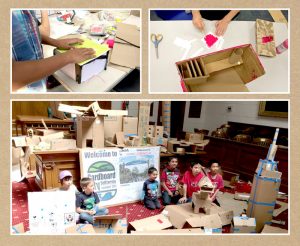
Photos courtesy of (clockwise from top left): Michigan Makers of the University of Michigan School of Information; Diana Rendina; Robert Pronovost
High-tech projects involving 3-D printers, laser cutters, and fancy video equipment are usually an easy draw for students, but ideas that involve cardboard, straws, and T-shirts can also deliver a big burst of STEAM without breaking the bank. We asked librarians and other experts around the country to share the most popular low-cost making projects they’ve seen or done. Here are some to try this year.
GRAB SOME STRAWS
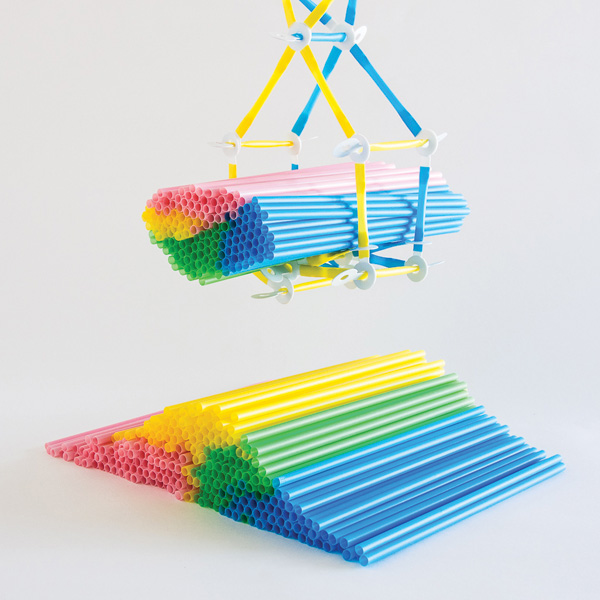
Photo by Strawbees
Straws lend themselves to lightweight building and are surprisingly resilient Strawbees, which are stronger and more flexible than regular straws, are designed for inexpensive prototyping activities; a pack of 200 colorful Strawbees costs $10. “I have seen students build catapult projects, engineering projects, and weight-bearing projects,” says Heather Moorefield-Lang, associate professor at the School of Library Information Science at the University of South Carolina. “Afterward, you just break them apart and start something new. They just keep giving.” Strawbee connectors are available in a kit for $20; students can also scan and print more on a 3-D printer, suggests Moorefield-Lang. If your library is equipped with a die-cutter, you can create your own connectors from old plastic containers (#2 and #4 plastics work best).
THROW A NO-SEW COSTUME PARTY
Adult-size, secondhand T-shirts can turn into all sorts of togs with a pair of scissors. “Kids can wriggle through the neck holes of an adult shirt and, using the ribbing as a waistband, create a T-skirt,” says Kristin Fontichiaro, clinical associate professor at the University of Michigan’s School of Information. She suggests cutting off the hem of a second shirt to make belts or braiding the strips to use as a hairpiece. Turn T-shirts into knights’ tabards by cutting a line straight down the shirt from the shoulder to the bottom, or create capes by cutting off the shirt front from the shoulder seams, leaving the ribbing intact. Discarded sleeves can become knit caps. Then kids can dress up in all these new garments to enact scenes from their favorite books. Fontichiaro recommends the activity for third graders on up; students need to be able to manipulate fabric scissors.
ROBOT ON THE MARCH
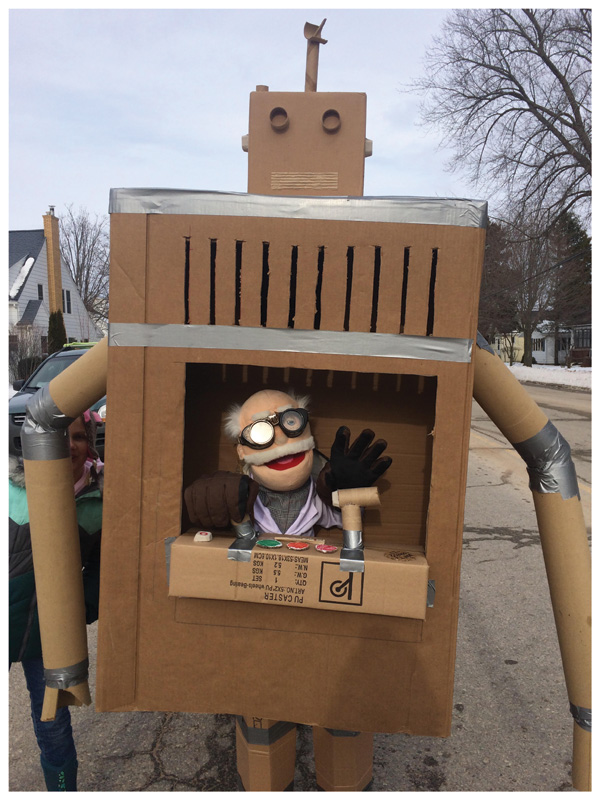 To publicize a Cardboard Challenge event at the Benzonia (MI) Public Library, this cardboard robot and puppet “marched” in a local parade, with information about the challenge—open to kids and adults interested in inventing, building, and crafting with cardboard—on its back. The robot was created by Jimmy McLaren, who is married to library director Amanda McLaren.Photo courtesy of Benzonia Public Library
To publicize a Cardboard Challenge event at the Benzonia (MI) Public Library, this cardboard robot and puppet “marched” in a local parade, with information about the challenge—open to kids and adults interested in inventing, building, and crafting with cardboard—on its back. The robot was created by Jimmy McLaren, who is married to library director Amanda McLaren.Photo courtesy of Benzonia Public Library
CREATE A CARDBOARD CHALLENGE
When then nine-year-old Caine Monroy built an arcade entirely of cardboard, he launched a movement and a website. Students can join this year’s global challenge—or be more open-ended and design their projects. To start, you’ll need to provide cardboard, glue guns or duct tape, paint or markers, and some cardboard-cutters. Robert Pronovost, a maker space consultant and founder of EmpowerMINT, dedicated to empowering students through making and innovation, likes to have students work with Makedo’s kid-friendly saws, which are included in a toolkit ($12.95 each, make.do). Diana Rendina, media specialist at Tampa (FL) Preparatory School, also recommends a battery-operated cutter from Skil (about $40 on Amazon.com).
Pronovost gets kids’ creative juices flowing by giving them stacks of cardboard, tape, butcher paper, and tools to build a cardboard city. Librarians can start by constructing one building, with or without student help, and have them work alone or in groups to add on. Spurring them on with questions leads to planning and innovation: Does this city need an airport? Would hotels be useful? What about a reservoir or city hall? The beauty of this project is that students of all ages, even preschoolers, can join in.
Heather Lister, a consultant for Mackin Educational Resources and a former teacher librarian, put a new spin on the cardboard challenge by giving her students the chance to create a plaything for her then two-year-old son. They asked him questions about his likes and dislikes and then crafted toys, including a marble run. The only parameter: every part of their creation had to be DIY. “What I really like about this project is that it not only focused on the invention and design process, but involved research and knowing your audience,” Lister says. She also liked that kids were creating for someone other than themselves, fostering empathy, and suggests that students could design for one another or for kids in other classes.
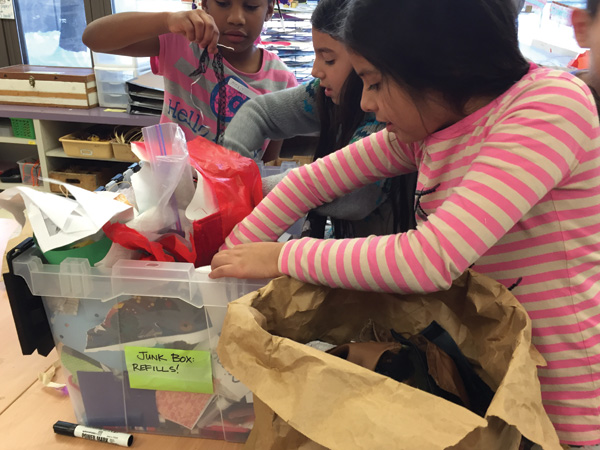
Michigan Makers participants sort through recycled materials to create gifts.
Photos courtesy of Michigan Makers of the University of Michigan School of Information
OPEN UP THE JUNK BOX
Free building material is all around, if you just look: It’s not too difficult to collect empty cereal or cracker boxes, toilet paper tubes, yogurt containers, broken toys, and more. Then add scissors, tape, glue, and a stapler to your stash. “Students can create the slowest marble maze or board games, prototype the next holiday must-have toy, or invent their own creations,” says Fontichiaro. Best of all, preschoolers on up will be able to make something—and tap into their problem-solving and design skills.
MAKE SQUISHY CIRCUITS
Play-Doh plus LED lights, a nine-volt battery, some wires (repurposed from old tech), and alligator clips can give kids the chance to fashion light-’em-up creations—including flags, animals, and motor circuits, among other projects. Pronovost suggests checking out SquishyCircuits.com for ideas, along with instructions for making your own conductive or insulating dough.
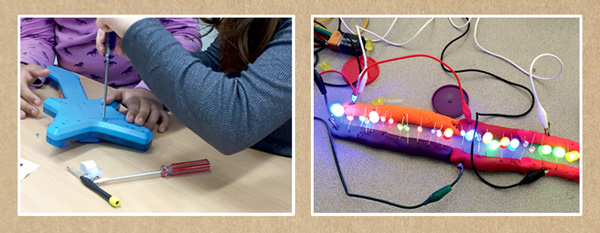
Michigan third graders take apart a toy guitar to see how it works (left);
multicolored squishy circuits.
Photos courtesy of Michigan Makers of the University of Michigan School of Information (left) and Robert Pronovost
TAKE APART OBSOLETE TECH
“Most schools have a closet somewhere that has a ton of old technology,” says Lister, whose own school had desktop computers dating back decades. Kids can dismantle old computers and repurpose what they find inside. One of her students made an exhaust system from the fans found inside the computers. Lister repurposed the wires to serve as conductive material for other projects—and for making cool jewelry. Not all schools have tech closets; if that’s the case, parents and community members are usually happy to donate. You’ll probably get a number of obsolete objects, including camcorders and cassette players.
BUILD SOME BRISTLE BOTS
Toothbrushes make great little robots, especially when you go to a dollar store and buy packs of battery-operated toothbrushes, says Lister. Snap the head off the toothbrush and find the vibration motor inside the motor. Then tape the vibration motor and battery on top of the bristles. Make sure the bristles are angled, Lister notes—if they aren’t, you can angle them by placing a heavy book on the bristles overnight. Bots can run races or be used as drawing machines by attaching markers.
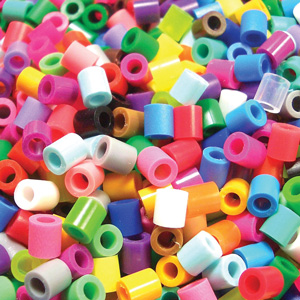 GET ARTISTIC WITH BEADS
GET ARTISTIC WITH BEADS
Students can make amazing creations with heat-fusible plastic beads known as Perler beads, says Rendina. She buys them from Amazon, but cheap ones are also available at Walmart. Kids can use plain, clear pegboards (also at Amazon) to create their own designs or depict their favorite fictional characters, using free, downloadable templates online. After the students have finished their bead artworks, place parchment paper over the designs and iron the beads to fuse them together. Rendina ironed her students’ creations and trained a few responsible eighth graders to help out.
INVEST IN SILHOUETTE PORTRAIT
This $99 digital cutting tool was originally designed for scrapbookers, but Fontichiaro also likes the fact that it doubles as a low-budget vinyl cutter that’s easy for children and grown-ups to use. Students can cut shapes to decorate laptop lids or smartphone shields. Fontichiaro also suggests that kids cut stencils from self-adhesive paper (like Contact) and use them, along with fabric paint or etching cream, to create designs on T-shirts or glassware gifts. As for materials, glassware and T-shirts are often available for $1 or less at secondhand stores, she notes.

Pizza boxes transformed into green screens.
Photo courtesy of Heather Moorefield-Lang
PUT PIZZA BOXES TO USE
Pizza boxes can make excellent portable green screens, as Travis Nelson, library media consultant at Richland County School District One in Columbia, SC, demonstrated to Moorefield-Lang. Nelson starts by painting the interior (top and bottom) of the boxes green. Then he attaches little characters to green straws procured from Starbucks and uses the Green Screen by Do Ink app ($2.99, iTunes) to make videos of puppet shows and stories.
Looking for more ideas? Check out Make It @ Your Library, where projects can be filtered by cost, suggests Lister.
Linda Rodgers covers health and education for a variety of magazines and websites.